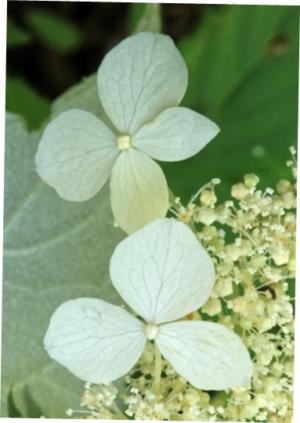Silverleaf hydrangea
(Hydrangea radiata)

Description
Hydrangea radiata is a species of flowering plant in the family Hydrangeaceae. It is commonly known as the silverleaf hydrangea or the snowflake hydrangea. The plant is native to Japan, where it grows in mountainous regions and can be found in areas with high humidity and cool temperatures. Description Hydrangea radiata is a deciduous shrub that can grow up to 2 meters in height and width. The plant has a dense and bushy habit, with multiple stems branching from the base. The stems are thin and brown, and the bark is smooth. The leaves are opposite, simple, and ovate to lanceolate in shape. They are about 5 to 10 centimeters long and 2 to 5 centimeters wide. The upper surface of the leaf is dark green, while the lower surface is covered with a silvery-white coating that gives the plant its common name. The leaves turn yellow in the fall before dropping. The flowers of silverleaf hydrangea are arranged in flat-topped corymbs that can be up to 10 centimeters in diameter. The inflorescence is composed of both sterile and fertile flowers. The sterile flowers are large and white, with four to six sepals that form a showy, star-shaped bloom. The fertile flowers are small and inconspicuous, with five petals and five stamens. The bloom period is from late spring to early summer. Distribution and Range Hydrangea radiata is native to Japan, where it can be found in mountainous regions and forests at elevations ranging from 200 to 2000 meters. The plant is widely distributed throughout the country, from Hokkaido in the north to Kyushu in the south. It is most commonly found in the central and western parts of Japan. Silverleaf hydrangea has also been introduced to other parts of the world as an ornamental plant. It is cultivated in gardens and parks in Europe and North America, including the United States, Canada, and the United Kingdom. However, it is not known to be naturalized in these regions and does not grow wild outside of Japan. Cultivation Hydrangea radiata is a hardy plant that is easy to grow and maintain. It prefers moist, well-drained soil that is rich in organic matter. The plant can tolerate a wide range of soil pH, but it grows best in slightly acidic to neutral soil. It requires partial shade to full shade, and it is sensitive to drought and heat. The plant can be propagated by softwood cuttings taken in early summer or by layering in the fall. The plant is often used as an ornamental shrub in gardens and landscaping. It is especially popular in Japan, where it is prized for its delicate foliage and showy blooms. The plant is also used in floral arrangements and as a cut flower. Uses Hydrangea radiata has several medicinal uses in traditional Japanese medicine. The leaves and stems of the plant are used to make a tea that is believed to have diuretic, anti-inflammatory, and analgesic properties. The tea is also used to treat urinary tract infections, edema, and rheumatism. In addition to its medicinal uses, silverleaf hydrangea is also used in the production of a traditional Japanese paper known as kozo paper. The bark of the plant is stripped and boiled to release the fibers, which are then washed, beaten, and formed into sheets. Kozo paper is known for its strength, durability, and fine texture, and it is used in a variety of applications, including bookbinding, printmaking, and calligraphy. Conservation Status The conservation status of Hydrangea radiata is currently listed as "Least Concern" according to the International Union for Conservation of Nature (IUCN) Red List of Threatened Species. While the plant is not currently threatened or endangered, it is still important to monitor its populations and habitat to ensure that it remains stable. The plant is sometimes harvested for use in traditional Japanese medicine, and over-harvesting could potentially pose a threat to its populations. Additionally, habitat loss due to urbanization and deforestation could also impact its distribution in the wild. Conservation efforts may include habitat preservation, monitoring of populations, and cultivation of the plant in gardens and parks to promote its preservation. Conclusion Hydrangea radiata is a beautiful and versatile plant that has many uses in both gardening and traditional Japanese medicine. With its delicate silver foliage and showy white blooms, it is a popular choice for gardens and landscaping. And with its diuretic, anti-inflammatory, and analgesic properties, it is a valuable medicinal herb. Whether used in the garden or in the medicine cabinet, Hydrangea radiata is a plant that is sure to impress.
Taxonomic tree:







